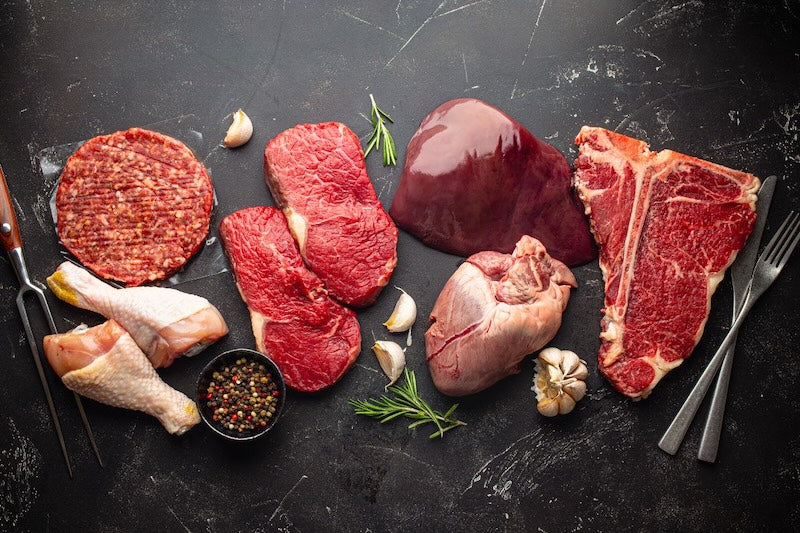A Deep Dive into History – Why Humans Evolved Eating Organs
Long before grocery‑store muscle cuts dominated our plates, our ancestors hunted animals and ate the whole thing—including organs, bones, brains, and marrow. Early humans needed dense nutrients to fuel growing brains—noses, hearts, livers, kidneys and marrow delivered vitamins, minerals, and fat. As one source puts it, “eating the whole animal including bone marrow and animal brains gave early humans the nutrient dense food they needed to feed the rapid growth of their own brains.” -Dr. Robert Kiltz
This nose‑to‑tail philosophy was embedded in cultures worldwide—from indigenous tribes to European peasant cooks. As The Weston A. Price Foundation notes, traditional diets worldwide respected the animal by using all parts, providing nutrient‑dense meals from organ meats and bone broth.
How Organ Meats Fell Off the Map—Big Ag & Marketing
So why don’t we eat those today? Several forces converged:
-Industrialization of food systems: Post‑World War II supermarket models prioritized uniform, high‑margin cuts. Muscle meats are easier to standardize and market.
-Marketing of “prime cuts”: Today’s meat industry prizes steaks, chicken breasts, and ground beef—leaving organ meats as low‑value byproducts.
-Cultural disconnect: As A&P pioneered American supermarkets, consumers shifted toward self‑serve plastic‑wrapped meat displays. Organ meats became foreign and stigmatized.
James Barry, on the Weston A. Price podcast, traces culinary traditions: organ meat consumption declined in modern Western cuisine as taste preferences and industrial supply chains favored uniformity.
Benefits of Nose‑to‑Tail Eating—for Health and the Planet
A. Nutritional Superpower
Organ meats pack in nutrients muscle cuts simply don’t match:
-Liver is rich in vitamins A, B12, iron, folate, and copper.
-Heart delivers coenzyme Q10 and bioavailable iron.
-Brain provides phosphatidylserine, sphingomyelin, peptides and BDNF-supporting molecules. As one source highlights: “organ meats are high in coenzyme Q10, zinc, selenium, iron, vitamins B2, B6, B12, choline, niacin, folate... nutritional value… extraordinary.” -Chris Mallula, Red House Ranch
Fergus Henderson, author of The Whole Beast, famously said: “If you're going to kill the animal it seems only polite to use the whole thing.”
Paul Saladino, a modern proponent, argues organ meats deliver unique growth factors unreplicated in muscle meat. One clip notes: “really good evidence that when you eat an organ it does have unique growth factors that are not present in other organs.”
Andrew Huberman (via his Lab) and Realmilk.com reference the ancestral wisdom: organ‑rich diets align with how human physiology developed and often yield superior metabolic outcomes.
B. Environmental and Ethical Upside
-Waste reduction: Eating offal cuts waste dramatically. Organ meats let fewer animals need to be reared, making animal husbandry kinder and less intensive.
-Resource efficiency: Using the whole animal reduces pressure on land and feed inputs.
-Celebrate the whole animal: Ethical carnivory isn’t about waste—it's about full utilization.
C. Real Experts Weigh In
-The Weston A. Price Foundation emphasizes traditional knowledge and richly nourishing organ traditions lost to modern diets.
-Paul Saladino and Framers like Realmilk.com champion raw milk plus organ‑rich ancestral diets as restorative.
-Voices like Ben Greenfield, Max Lugavere, Mark Sisson, Dr. Mark Hyman, Dr. Josh Axe, and Shawn Baker have promoted liver pills or raw‑meat approaches. While some lean extreme (e.g. carnivore), most acknowledge organ‑meat nutrients are essential.
-Heart and Soil Supplements and Dr. Mercola even market grass‑fed organ capsules (“desiccated liver pills”) as multivitamin analogues.
-Robert Lustig, though more focused on sugar toxicity, also recognizes nutrient‐dense food over junk food is key to health.
-Natalie Crawford, Jaime Seeman, and others in the ancestral niche emphasize organ supplements to bridge modern convenience with traditional nutrition.

How to Incorporate Organ Meats
A. Whole‑food Recipes to Ease In
Liver pâté is classic: sauté onions, garlic, herbs; add chopped liver (chicken or beef), pan‑fry lightly; blend with butter or cream. Serve on crackers or vegetables.
Heart stir‑fry: thinly slice beef or lamb heart, marinate in citrus, garlic, soy; stir‑fry quickly with veggies for a lean, flavorful dish.
Bone‑broth using oxtail, knuckle bones, marrow + organ trimmings yields collagen and gelatin for gut & joint support.
Tripe stew: slow‑cook tripe with tomato, onion, spices—rich and filling.
Sweetbreads or pancreas “nuggets”: lightly dredge in flour, sauté until crispy—rich in rare nutrients.
B. Practical Tips
Start with chicken liver or organ blends (easier flavor).
Mix into burgers, meatballs, meatloaf (5–10% organ is tolerance-friendly).
Use desiccated liver capsules if you truly can’t stomach taste.
C. Sample Weekly Schedule (approx):
Monday: Liver pâté with crackers
Tuesday: Ground beef and liver burgers
Wednesday: Bone broth soup with organs
Friday: Heart stir-fry with jasmine rice
Weekend: Meatballs with organ blend

Organic Grass‑Fed Organ Supplements
If cooking isn’t your thing, reputable supplements are available:
Heart & Soil offers grass‑fed, desiccated beef or bison liver capsules—purported as a natural multivitamin.
Weston A. Price Foundation–aligned producers (often linked via Realmilk.com communities) sell raw liver products or freeze‑dried powders.
Dr. Josh Axe and Dr. Mercola have branded liver‑supplement lines.
Ben Greenfield and Max Lugavere also discuss these supplements in their wellness content.
Note: for supplements, look for labels certified grass‑fed, pasture‑raised, lab‑tested for toxins, ideally from third‑party sources.
Research & Voices (Quotes and Summaries)
Weston A. Price Foundation: traditional societies used whole‑animal nutrition—they argue modern deficiency diseases stem in part from ignoring liver, bone broths and organ‑rich caldo.
Paul Saladino: “there’s actually really good evidence when you eat an organ it has unique growth factors not present in other organs.”
Andrew Huberman: emphasizes ancestral nutrition and organ inclusion for hormonal and metabolic function. Realmilk.com echoes traditional raw‑milk and organ nutrient synergy.
James Barry (on Weston A. Price podcast): explains culinary tradition history and why we rejected organ meat in industrial era.
Although research on modern organ‑supplement efficacy is still emerging, the nutrient concentration of organ tissue is widely documented. Heart and Soil supplements or desiccated liver test show high B12, A, folate and trace minerals.
Pros and Cons (Straight Talk)
Pros:
-Ultra‑nutrient dense.
-Affordable (often cheaper than steaks).
-Environmentally friendly—less food waste, better use of resources.
-Supports circulation (iron, B12), brain (choline, BDNF precursors), energy metabolism (iron, CoQ10).
Cons / cautions:
-Taste & texture can be off‑putting for many.
-Heavy metals can accumulate in some organs if sourced from poor farms—choose grass‑fed certified.

Summary
We evolved on nose‑to‑tail diets—rich, complete, sustainable. Then industrial food chains and marketing favored fillets and trimmed steaks, turning organ meats into low‑value byproducts.
Experts from Weston A. Price Foundation, Paul Saladino, Andrew Huberman, Ben Greenfield, and others remind us organ meats are nutritional gold‑mines. Heart & Soil, Dr. Mercola, Josh Axe, and Mark Sisson underscore organ supplements as practical modern bridges.
Whether you try liver pâté, heart stir‑fry, bone broth, or go the capsule route—incorporating organs into your diet is likely the single most powerful way to reintegrate ancestral nutrition, cut waste, and supercharge your health.
Recipes Quick Recap
Liver pâté: sauté liver + aromatics, blend with butter, chill.
Heart stir‑fry: slice thin, marinate, stir‑fry with veggies.
Bone broth: simmer bones + organ scraps 12 h with vinegar & herbs.
Organ‑mixed burger: ~10 % liver/chopped heart in ground beef patties.
Product Picks (Supplements)
Though I’m keeping it unbiased, brands like Heart & Soil Supplements, Dr. Mercola, or raw‑food outlets tied to the Weston A. Price network all offer grass‑fed, desiccated liver capsules. Look for third‑party tested quality.
Final word: Don’t sugar‑coat it—organ meats aren’t gourmet at first bite. But they’re powerful. Start slow, try recipes, respect your preferences. Your ancestors ate them for a reason—and your body might just thank you.
Hunghee Ancestral Energy is grounded in primal nutrition—packed with the most bioavailable animal-based nutrients and fueled by fat for performance, clarity, and adventure. Whether you're chasing peaks, hitting the gym, or just managing the chaos of everyday life, Hunghee's 1oz on-the-go packs deliver clean-burning, fat-fueled energy rooted in evolutionary wisdom. Made with organic grass-fed ghee, local raw honey, and ancient sea salt, Hunghee is fuel the way nature intended.
Disclaimer: This content is for informational purposes only and is not intended as medical advice. Please consult your healthcare provider for advice about a specific medical condition or before starting any new fitness or nutritional program.

